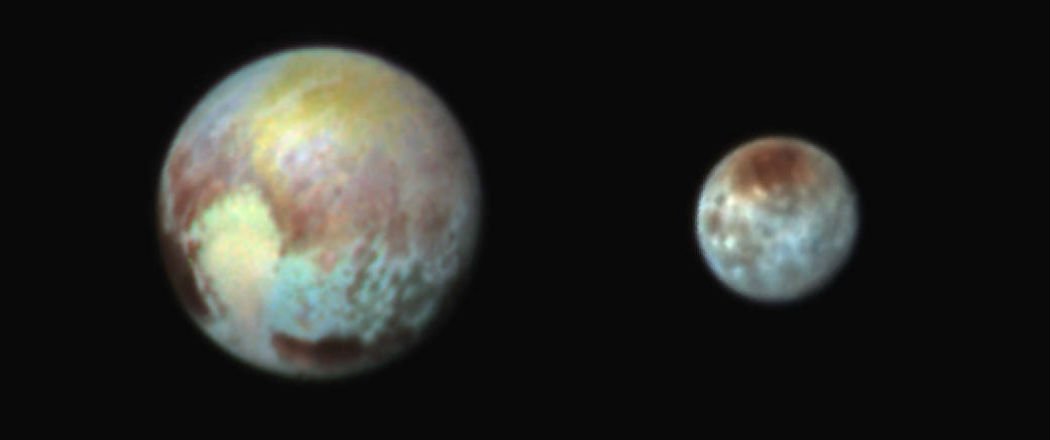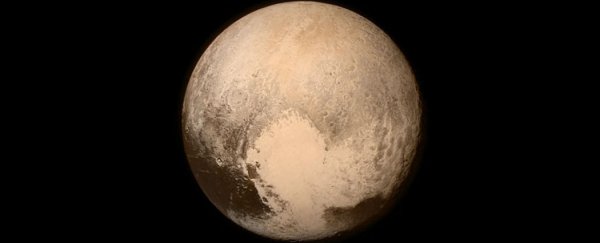After 9.5 years and 4.8 billion kilometres (3 billion miles), NASA's New Horizons spacecraft has finally managed to fly as close to Pluto as humans have ever been - roughly 12,472 km (7,750 miles) away, which is about the distance from New York City to Mumbai in India. This is the first-ever space mission to explore a planetary body so far from Earth, and New Horizons is expected to take 16 months to transmit almost a decade's worth of data back to Earth.
"After nearly 15 years of planning, building, and flying the New Horizons spacecraft across the Solar System, we've reached our goal," project manager Glen Fountain from the Johns Hopkins University Applied Physical Laboratory (APL) said in a press statement. "The bounty of what we've collected is about to unfold."
While we wait to find out what the data collected by New Horizons can reveal about Pluto and its five known moons, we can take the time to appreciate the sheer awesomeness of the clearest and most detailed image of the dwarf planet ever captured (see above).
Taken by the Long Range Reconnaissance Imager (LORRI) aboard the spacecraft on July 13, when it was 768,000 kilometres (476,000 miles) from the surface, the image features a large, bright patch that's been nicknamed 'the heart', which stretches around 1,600 kilometres (1,000 miles) across the surface. It's not clear yet why the surface area of the heart is so smooth and featureless, but the team at NASA thinks it could be the result of ongoing geologic processes below the surface.
New Horizons - which is currently hurtling through space at speeds of up to 48,280 km/h (30,000 miles/h), making it the fastest spacecraft ever launched - also sent back an incredibly detailed image of Pluto and its closest moon Charon on July 13 (see below.) NASA scientists have applied false colour to the image to highlight the differences in surface material and features on each planetary body.
"These images show that Pluto and Charon are truly complex worlds. There's a whole lot going on here," New Horizons co-investigator Will Grundy from Lowell Observatory said in a press release. "Our surface composition team is working as fast as we can to identify the substances in different regions on Pluto and unravel the processes that put them where they are."
 Credit: NASA
Credit: NASA
The purpose of the colour data is to help the researchers figure out the molecular composition of surface features such as accumulated ice, the geology of rocky formations inside the craters, or the kinds of damage caused by radiation. Already we can tell that the two halves of the heart have distinct compositions, with the western lobe - shaped like an ice-cream cone - coloured in a peachy green hue, while the eastern lobe is more blueish-green.
What could that mean? We'll have to wait for the data to arrive from New Horizons - and I mean wait, because it can only manage to transmit it at speeds of 2,000 to 4,000 bits per second - but here are a few things we know so far, and can look forward to in the coming days, according to Mika McKinnon at io9:
- It has a methane and nitrogen ice cap on its north pole, where temperatures fluctuate between -233 and -223°C. And it could have snow, but skiing on it would be like skiiing through sand, as Kelsi Singer from the New Horizons team told Reddit in an AMA: "If there was snow, it would be quite frictiony, like skiing on sand, because it is sooooo cold there. It would not be like the snow on Earth, which is actually quite balmy compared to Pluto."
- We might actually find another of Pluto's moons tomorrow, says McKinnon: "We haven't actually ruled out spotting more moons hiding amongst the orbits of the known moons. Taking a good look around for any stray satellites chillin' around Pluto is part of New Horizons objectives over the next few days."
- Tomorrow we will get to see a 3D image of Pluto, which will give us a better idea of the shapes of the surface formations, including chasms, valleys, mountains, and craters.
- Tomorrow we'll also see Pluto's moon Hydra for the first time. Well, for the first time as something other than a handful of blurry pixels.
The fruits of New Horizon's labour are only just beginning to drop. We've got 16 more months of this. Head over to io9 for more details on what's in store.
